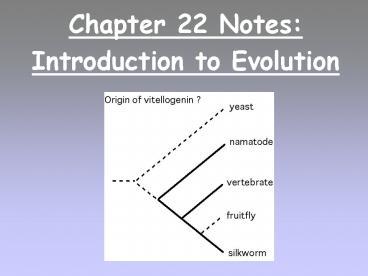Chapter 22 Notes: Introduction to Evolution PowerPoint PPT Presentation
1 / 21
Title: Chapter 22 Notes: Introduction to Evolution
1
Chapter 22 Notes Introduction to Evolution
2
- Our planet is home to a huge variety of
organisms - (Scientists estimate 5-20 million species of
organisms alive today!) - Even more amazing is evidence of organisms
that once lived on earth, but are now extinct
Dodo bird
3
- Several hundred million species have come and
gone during 4.5 billion years life is believed to
have existed on earth - Sowhere have they gone why have they
disappeared?
4
- TERMS TO KNOW!!
- EVOLUTION the process by which modern
organisms have descended from ancient organisms. - (CHANGE OVER TIME)
- Central Idea organisms alive today have been
produced by a long process of change over time. - FITNESS refers to traits and behaviors of
organisms that enable them to survive and
reproduce
5
- COMMON DESCENT species share common ancestors
- ADAPTATION any inherited characteristic that
enhances an organisms ability to survive and
reproduce - based on variations randomly inherited
6
HOW DO WE KNOW THAT EVOLUTION HAS OCCURRED (and
is still happening!!!)???
7
Lines of Evidence
- 1. So many species!
- -at least 5 million species (250,000 beetles!)
8
- 2. Biogeography
- -Distribution of plants and animals
- -Example 13 species of finches on the 13
Galapagos Islands - -57 species of Kangaroos all in Australia
9
(No Transcript)
10
Lines of Evidence (cont.)
- 3. Age of Earth
- - Rates of motion of tectonic plates
- - Radioactive dating
11
- 4. FOSSILS
- - Evidence of once-living things(shells, casts,
bones, teeth, imprints, preservation in ice,
amber, tar or peat) - - Show a succession of forms through a vast span
of time
12
(No Transcript)
13
Lines of Evidence (cont.)
- -We see progressive changes based on the order
they were buried in sedimentary rock - Few fossils/species many
fossils/species - Simple organisms complex organisms
14
Lines of Evidence (cont.)
- 5. Applied Genetics Artificial Selection
- - We see DDT-resistant insects special crops
Insecticide applied
15
- 6. Homologies shared common anatomical or
biochemical traits - - Forearm bones
- - Embryos of vertebrates
16
(No Transcript)
17
- 7. Vestigial Organs
- - Leftovers from the evolutionary past
- - Structures that no longer serve their purpose
18
(No Transcript)
19
- 8. Molecular/Biochemical Homologies
- - DNA is the universal genetic code or code of
life - -Proteins (sequences of amino acids)
20
(No Transcript)
21
- ANALOGOUS STRUCTURES
- NOT EVIDENCE!!
- similar in function, but not in internal form
- ex butterfly wing vs. bird's wing
- VS.
- both fly, but butterflies don't have bones so
support their wing whereas birds do DNA
instructions are different

